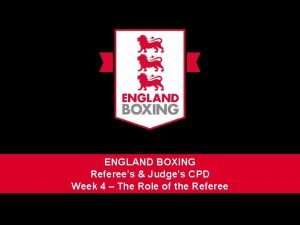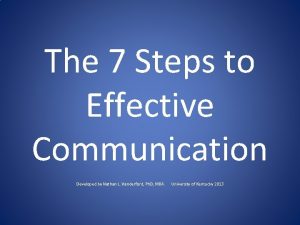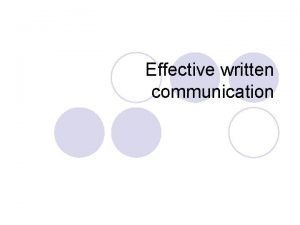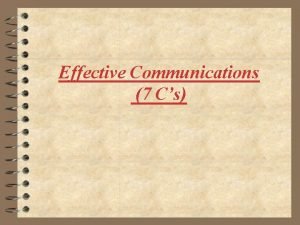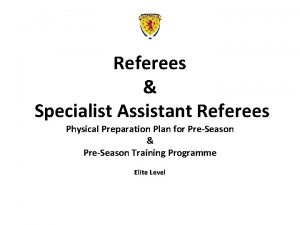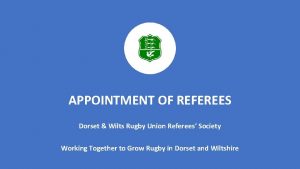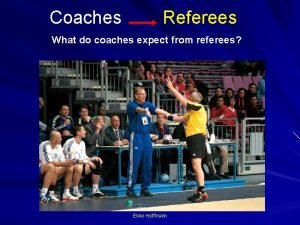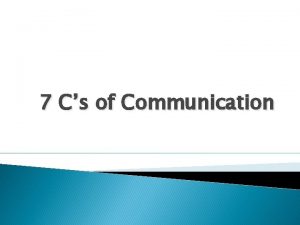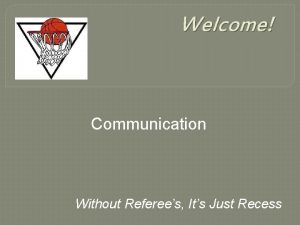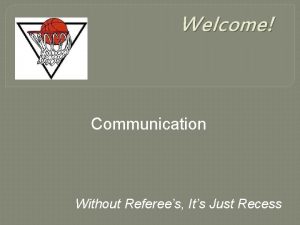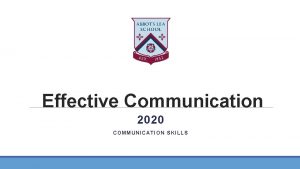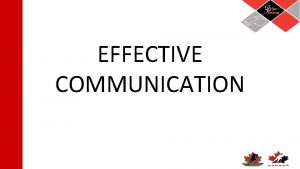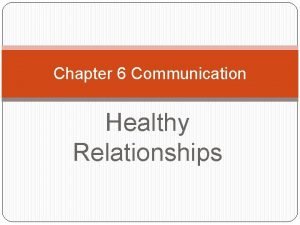Effective Use of the Communication System for Referees


















- Slides: 18

Effective Use of the Communication System for Referees, Assistant Referees and the 4 th Official Originally Authored by: Joe Fletcher (CAN) Mark Geiger (USA) Adapted/Modified by: James Conlee Changes include removing clips, changing text size, adding images, and adding/editing text

Primary Purpose The communication system is intended to help members of the referee team to better assist one another • It is NOT meant to replace the signals and mechanics that have been in use • In the event that the comm system fails, all of the standard communication mechanics will apply.

Preparation You MUST discuss comm system use during the pre-game discussion. Discussion must occur even if you have experience and comfort with system, and even if you have worked with the crew members and they have experience. • Discuss what to do if the system fails during a match

The Ground Rules Speak clearly and loud enough to be heard • Avoid negatives, unless you are only saying “No” • “No No No” or “nothing there”– gets a point across • “No Foul” – could be a problem if the referee only hears “Foul” •

The Ground Rules • The TIMING of any input is just as important as the advice being given • Suggesting a caution after play has restarted is not helpful • Avoid talking when the Referee or AR is highly concentrated or already involved in dialogue with players, unless it is time -critical • Avoid talking when referee is in a crowd of players. Wait until the referee makes eye contact or asks for input

The Ground Rules • Use short phrases that can be repeated, which is helpful as the Referee/AR may or may not hear you the first time • The AR should not say “foul” when the result will be a penalty kick. Instead, the AR should say “penalty” • It helps the Referee to hear the AR speaking to players. The Referee can decide if additional presence is needed, or can follow up on the message already given

The Ground Rules • When the referee is moving up field the referee may ask the trailing AR to watch for potential problems or problem players • The referee can ask the AR to come on the field to obtain the proper distance for free kick • The Referee can ask the 4 th official to allow a player back onto the field of play after an injury • The Referee team should discuss “additional time” needed, usually by 43 or 87 th minute. • Pending referee instructions, the referee team can offer motivation or encouragement

The Basics – From AR to Referee Throw in: Say the jersey color of the team that will be taking the throw, Corner, or goal kick A Tight Decision on the goal line or touch line: Say “Good” or “Still in” for when the ball remains in play If a restart is taken quickly : Say the “Ball in” so all members of the team are aware that the ball is in play (can be Referee to AR as well) Alert the referee to violent conduct behind the referee’s back

Offside – From AR to Referee Broadcast offside decisions when the ball is kicked. This makes it easier for the referee to anticipate a flag or start to run Avoid saying “onside” as it sounds too similar to “offside” “He’s good” or just “good”, The referee may be ok with announcing attacker in offside position by stating “position”, or “xxxxxx position”. This early information can tell the referee when to expect a flag (or not) To help differentiate, the Referee may ask the AR to repeat “offside” 3 x vs saying “he’s good” only once. Again, another way to differentiate the two in the event the message doesn’t come through clearly

Offside – From AR to Referee If the AR is unsure which player touched/played the ball through to an offside positioned attacker: • AR should say “Help, Touch? ” • Referee will reply “Touch” (refers to attacker) or “Defender” (keep flag down) • Ideally the Referee will anticipate this situation and say “Touch” or “Defender” when the play occurs so the AR can move to the next phase (talk about this in pregame).

Offside – From AR to Referee If A player is in an offside position and the AR is unsure if the player is interfering with an opponent • AR can say “line of vision” or “position - #9 ” • It is then up to the referee to say “offside”, “goal”, or “keep playing”, or whatever else is appropriate. • If goal is scored, AR can stand at attention and then initiate dialogue w referee.

Fouls – From AR to Referee • If AR sees foul that the referee may not see, the AR can say "foul”. • If the AR is in a more credible position or has best angle, the AR should then support with flag. For example, handball on the Referee’s diagonal the AR can say "handball" - giving the Referee the chance to blow right away • • Fouls right in front of AR should be supported with standard flag mechanics. •

Misconduct – From AR to Referee • AR advice on 100% misconduct must be given. • Avoid saying “I think”, or “at least” a yellow when trying to decide between a yellow or red card • If the AR doesn’t know, the AR should not guess • The AR can advise the Referee to verbally warn a player vs giving a yellow card • The AR should advise the Referee about persistent infringement and players being targeted

Misconduct – From Referee to AR • When the Referee calls the foul and is “between yellow and red” • Can say “I have yellow” or “I have red” • The Ref can invite the AR to contribute • The AR should give an opinion in this instance but should be clear if not 100% sure.

Tactical Info – From AR to Referee • For potential quick transitions, the lead AR can inform the referee about counter-attack scenarios (i. e. numbers up on counter, etc). • This info can tell the Referee whether the need exists to sprint immediately, or whether it is ok to save energy when moving up field • Trail AR should monitor players that are not in view of referee when no threat of offside exist.

Oh No…. . Help!! • Should the Referee end up far behind play on a counter attack – The Referee should say “Help” or “Oh. . ” • This alerts the lead AR to be prepared to act on behalf of the referee. The AR may signal for fouls in the center of the field during the time while the Referee is too far away • The Referee will tell the AR when caught up and in position, so AR knows when mechanics return to normal

Some Final Suggestions - Teamwork • The Referee should acknowledge having heard teammates (verbal, hand wave, or gesture). • The Referee may assign responsibilities to the trailing AR at restarts - allowing the Referee to focus elsewhere • • e. g. Position of the ball and handball by players in the wall The referee needs to make comm use directives clear with crew members during pregame so that everyone fully understands protocols.

Questions? ? ?
 Cv reference
Cv reference Dorset and wilts rugby referees
Dorset and wilts rugby referees Referees
Referees Ehf referees
Ehf referees Writing effective use cases by alistair cockburn
Writing effective use cases by alistair cockburn The art of using language effectively
The art of using language effectively Use of overhead projector
Use of overhead projector Facilitator style teaching
Facilitator style teaching The judicious and effective use of energy
The judicious and effective use of energy Art of using language effectively
Art of using language effectively Objectives of written communication
Objectives of written communication 7 steps of effective communication
7 steps of effective communication The 5 inevitable laws of effective communication
The 5 inevitable laws of effective communication Factors affecting the communication process
Factors affecting the communication process Effective written communication
Effective written communication Consideration in communication
Consideration in communication Site:slidetodoc.com
Site:slidetodoc.com Importance of effective communication
Importance of effective communication Effectively communicate meaning
Effectively communicate meaning


